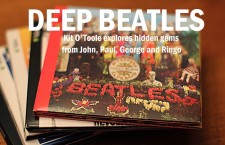Recently I’ve received requests to examine “Rain,” the groundbreaking B-side to “Paperback Writer.” Indeed, “Rain” has transformed into one of the Beatles’ best-loved B-sides, a masterpiece both musically and lyrically. In addition to being simply a wonderful song, it signaled the next phase in the band’s evolution, one which would see massive changes in their sound and image.
By 1966, the Beatles were coming off their next feature film, “Help!,” which maintained their early “mop top” look while subtly introducing more introspective lyrics (“You’ve Got to Hide Your Love Away”), sexuality (“Ticket to Ride”), and the beginnings of George Harrison’s experiments with Indian music. These motifs continued in their followup, Rubber Soul, which represented an even greater leap forward in maturity (“In My Life”) and sophistication (“Norwegian Wood”). After Rubber Soul’s release and critical acclaim, the Beatles found themselves back at Abbey Road recording what would become one of their finest works, Revolver. As was typical at the time, EMI/Capitol pressured George Martin and the group to issue a single; thus the tracks “Paperback Writer” and “Rain” were removed from the album-in-progress and released on May 30, 1966 in the US, and on June 10, 1966 in the UK. By itself, “Rain” peaked at No. 23 on the US: charts; billed as a double single with “Paperback Writer” in Britain, the song reached No. 1. Perhaps the seemingly radical change in sound, along with a trippy music video, confused some fans expecting “I Want to Hold Your Hand,” but 46 years later “Rain” is widely considered one of their finest songs.
The story behind “Rain” remains somewhat muddled due to conflicting memories. According to the Beatles Anthology, John Lennon wrote the track after the group arrived in a rain-soaked Sydney, Australia while on tour. “We were having hysterics, laughing. It was so funny, coming to Australia and getting on a big van, all soaking wet; we thought it was going to be sunny. We only got wet for about fifteen minutes, but the kids got wet for hours,” Lennon later said. “How could we be disappointed when they came out to see us and stood in all the rotten wind and rain to wave to us? They were great, really great. I’ve never seen rain as hard as that, except in Tahiti.” This incident inspired Lennon to compose a tune about “people moaning about the weather all the time.” In Anthology, McCartney recalled “Rain” as a joint effort: “I don’t think ‘Rain’ was just John’s. We sat down and wrote it together. It was John’s vocal and John’s feel on the song, but what gave it its character was collaboration.”
The Beatles commenced recording the track on the same day as “Paperback Writer”: April 14, 1966. After spending much of the day working on “Paperback Writer,” they began work on “Rain” in the evening session. Recording five takes, the Beatles utilized the same sound effects they had previously used on the Revolver track “Tomorrow Never Knows.” According to engineer Geoff Emerick, that track taught them that the texture and depth of certain instruments sounded really good when slowed down. With “Rain,” the Beatles played the rhythm track really fast so that when the tape was played back at normal speed everything would be much slower, changing the texture: “If we’d recorded it at normal speed and then had to slow the tape down whenever we wanted to hear a playback it would have been much more work.”
In the video below, one can hear the original tempo before it was slowed down. Ringo Starr added his now famous drum part, which he has claimed many times was his finest performance. Harrison performed his lead guitar portion, and Lennon played rhythm guitar, heavily distorted in the final version, and his lead vocals. McCartney may have laid down a bass line, but he recorded the final version in the next session.
April 16 saw many more overdubs and finishing touches to “Rain.” In a marathon 11-hour session, McCartney performed his complex bass part, Starr added tambourine, and McCartney, Lennon, and Harrison completed backing vocals. Then came one of the song’s most fascinating elements: the backwards speech toward the end. Again, opinions differ as to whether Lennon devised this technique. In a 1980 interview, Lennon said that he always listened to the group’s work from that day’s recording session after returning home from the studio. “Somehow I got it on backwards and I sat there, transfixed, with the earphones on, with a big hash joint. I ran in the next day and said, ‘I know what to do with it, I know … Listen to this!’ So I made them all play it backwards.” However, Martin told Mark Lewisohn in 1988 that he had been playing around with the day’s tapes and decided to experiment with altering Lennon’s voice. “So I lifted a bit of his main vocal off the four-track, put it onto another spool, turned it around and then slid it back and forth until it fitted. John was out at the time but when he came back he was amazed. Again, it was backwards forever after that.”
Despite this conflicting information, it cannot be denied that one particular element added an unmistakably psychedelic, hallucinogenic quality to “Rain.” Once recording was completed, Martin and Emerick made four mono mixes of the track, with the third version being selected for the single. To promote the song, the group filmed three videos (all directed by Michael Lindsay-Hogg) for US and UK television: one where the group wanders in a garden and greenhouse, and the other two (one in black and white, the other in color) featuring the Beatles lip-synching to the song in a studio.
Several elements make “Rain” an outstanding song in the Beatles catalog. First, Starr proves his skill as a drummer by performing some off-kilter patterns, utilizing his typical powerful style. Second, McCartney’s bass throbs throughout the track; listen closely to just his part to experience the complicated, swirling lines. In addition, Lennon demonstrates how he could alter his voice to fit a “role,” this time a narrator guiding the listener through an otherworldly atmosphere. As a precursor to “Tomorrow Never Knows,” “She Said She Said,” “I’m Only Sleeping,” “Lucy in the Sky with Diamonds,” and numerous other compositions, “Rain” concerns a hallucinatory dream world, Lennon draws out some syllables, lets raspiness creep in, and fluctuates in tone to emphasize the fantastic lyrics. “Can you hear me, that when it rains and shines; it’s just a state of mind?” Lennon asks, stressing the words “state of mind.” “Rain” may have originally concerned weather, but this line suggests something more cerebral.
Other lines address another familiar Lennon theme: people not wanting to move beyond their borders, those “nowhere men” who resist change in thought or culture. “If the rain comes, they run and hide their heads; they might as well be dead,” he complains. In contrast, this narrator declares: “Rain, I don’t mind; shine, the weather’s fine.” Rain is nothing to fear, Lennon adds: “I can show you that when it starts to rain, everything’s the same.” Lennon uses another favorite technique — directly addressing the listener — by crying “Can you hear me”?” and “I can show you” numerous times. Think of “Rain” as an extension of Rubber Soul’s “The Word” or “Think for Yourself,” this time overtly encompassing psychedelia and, through its sound, the emerging drug culture.
“Rain” may not have been a huge hit — in fact, it’s difficult to believe it originated as a B-side — but it holds a very important position in the Beatles catalog. It marks the official transition from the “Beatlemania” years to the mature, experimental, forward-thinking band who would revolutionize rock music. Rubber Soul provided hints of this transition by moving even further away from traditional pop music, but “Rain” and later Revolver officially signaled Beatles, Mach Two.
- The Rescued Early Paul McCartney Song That Completed ‘Beatles For Sale’ - December 4, 2024
- A Rare Beatles Cover Proves John Lennon Was Wrong About His Voice - November 26, 2024
- How John Lennon Came Roaring Back on the Beatles’ White Album - November 22, 2023




The group is Tip Top on this fantastic number. Always
loved this song and its dreamlike ways. And to think you
also have Paperback Writer on the other side of this 45.
Not bad value at $1.05 here in Canada. Pretty darn good
single and I still have the picture sleeve.
Many people think Revolver was the best Beatles’ album ever. Others say Sgt. Pepper, or the White Album, or Abbey Road, or any other album of the Fab Four for any number or reasons.
Personally, I’ll usually say Revolver by a slight margin, but just imagine if Paperback Writer and Rain had been part of the album? Add those two songs to She Said She Said, Tomorrow Never Knows, Taxman, I’m Only Sleeping, Eleanor Rigby….. that’s only seven songs – pick any other seven and you still have the greatest album the Beatles could have ever made by a long shot.
‘Revolver’ isn’t the only one that would have benefited. The Beatles’ habit of releasing stand-alone singles, though admirable, certainly made ‘Sgt. Pepper’ a weaker project. Imagine that album with the addition of “Strawberry Fields” and “Penny Lane.” In every mix tape I ever did of White Album tracks, I always included “Hey Jude,” “Inner Light” and “Lady Madonna.” Picture ‘Let It Be’ with the 1969 singles “Don’t Let Me Down,” “The Ballad of John and Yoko” and “Old Brown Shoe.” There really was just an embarrassment of riches.
Agreed, Randy–definitely one of the best bargains ever! Thanks for commenting.
I believe that Paul will claim authorship of Imagine pretty soon.
Oh yeah – add Strawberry/Penny Lane – make a better Sgt. P. Better yet, take Sgt. P and MMTour – which are all the Beatles’ 1967 releases and make a “Best of ’67’ album.
Actually – more than anything I was happy to find out I’m not the only person that rearranges the classics. Even Mr. Springsteen himself has been known to agonize over running orders and selections.
I just LOVE reading ANYTHING that basically anybody writes about THE BEATLES as I was very fortunate to be born in 1946 just a few streets away from RINGO (& BILLY FURY)& we attended the same Youth Club in DINGLE, LIVERPOOL 8. I knew Ringo& Billy very well as we all attended the same school & my elder brother was part of the Cavern Stable with Earl Preston’s REFLECTIONS. I was a regular at The Cavern remembering the Merseybeat scene in its infancy & growing up to a MASSIVE Audiance. I really do know how lucky I am to have so many fond memories. Those of you that dont know, The Cavern Club NEVER sold Alcohol ONLY Soft Drinks like Coka-Cola in Glass Bottles, IF you wanted an Alcoholic Drink then a PASS-OUT was available so we would walk down Button Street to THE GRAPES PUB which still exisits or pop over to THE IRON DOOR CLUB less than 100 yards away to hear other Merseyside Groups. Oh What WONDERFUL DAYS !!